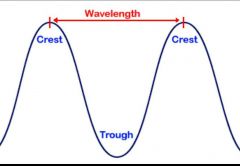![]()
![]()
![]()
Use LEFT and RIGHT arrow keys to navigate between flashcards;
Use UP and DOWN arrow keys to flip the card;
H to show hint;
A reads text to speech;
6 Cards in this Set
- Front
- Back
|
Simple Harmonic Motion |
-The more you pull an object one way, the more it wants to return to the middle. (Spring with mass on end, pendulum) -velocity is greatest in the middle and acceleration will be greatest at the max displacement -Time period of pendulum: T=2pi√L/G |
|
|
Wave Length |

-Distance between successive crests of a wave -wavelength for standing waved (L is length of string and n is number of antinodes) upsidedownYn= 2L/n -measure in meters |
|
|
Frequency (and how it relates to pitch) |
- (pitch=frequency) Frequency is how often wave per time >f=1/T and period is T=1/f. f is in hertz(hz) -sound moving away from you has a lower frequency and sound moving towards you has higher frequency. Inside source, frequency is the same -Natural frequency: if you hit an object that has vibrational property it will vibrate at the same frequency automatically -Resonance:something is forced to vibrate at its natural frequency -more waves that occur is a higher frequency |
|
|
Crest and trough |
Crest: the highest point the medium rises to Trough: the lowest point the medium sinks to (medium is the substance which the wave travels through) |
|
|
Amplitude (and how it relates to volume) |
-Amplitude of sound waves=volume -height from equilibrium point to the crest or trough. Energy is also measured by amplitude. -Small amp=low energy; high amp=high energy -Amp is measured in meters -when two waves combine, add their amps to get total amp |
|
|
Transverse wave and longitudinal wave |
-Transverse Wave: vibration is perpendicular to the direction of travel -Longitudinal Wave: vibration is parallel to the direction of travel |

